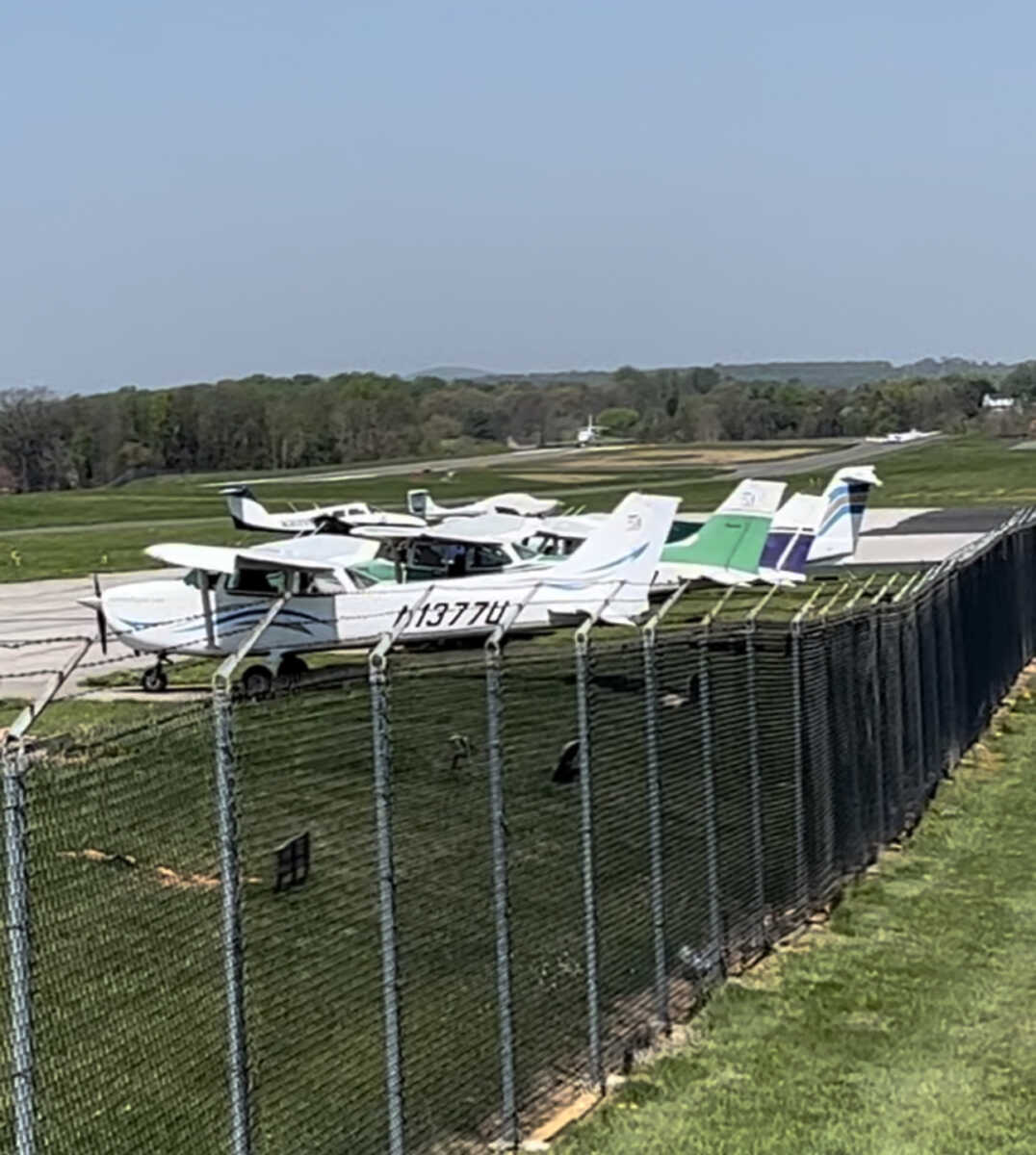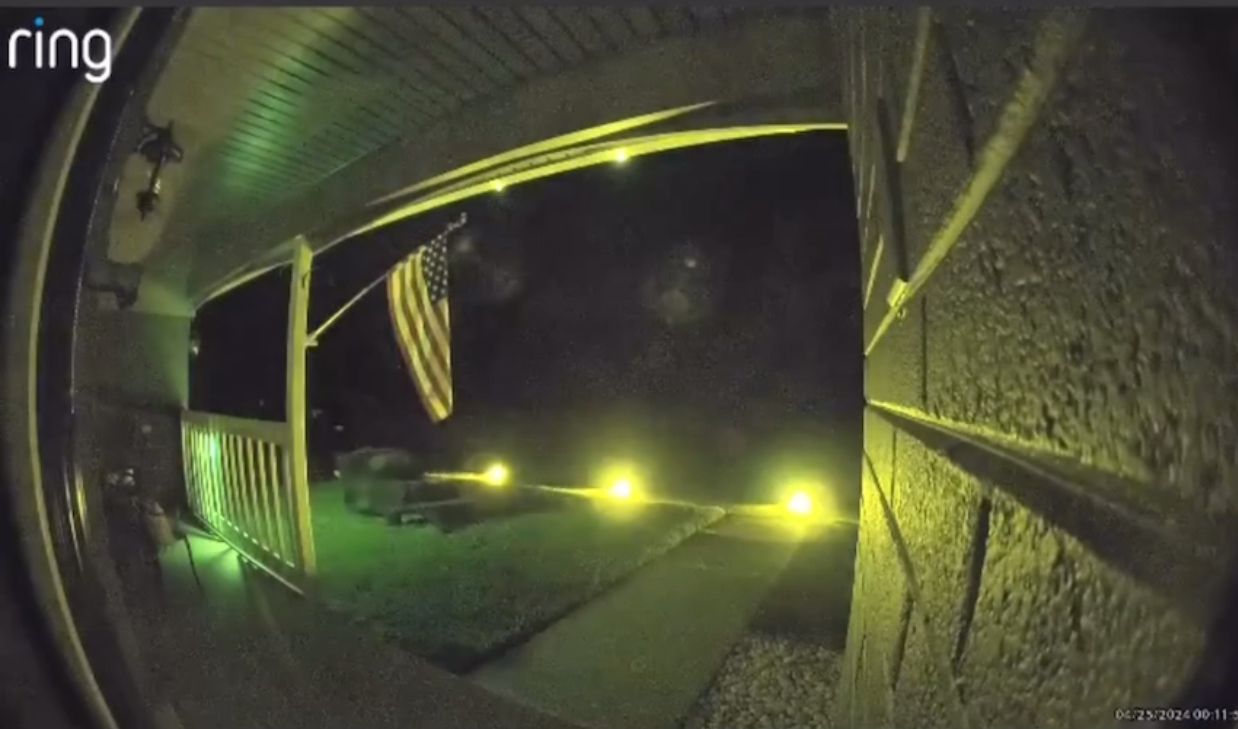
On February 13, the Transportation & Environment Committee will discuss the findings of the Office of Legislative Oversight (OLO) Report 2022-2, The Montgomery County Airpark: Regulatory Framework and Community Impacts, which the Council received and released on January 25, 2022. OLO will present a summary of the report at the Committee meeting (available below).
The County Council directed OLO to prepare a report that describes the governance, regulatory framework, and community impacts of the Montgomery County Airpark. The Council further asked OLO to present information on the number of aircraft flying in and out of the Airpark as well as the noise and environmental effects of Airpark operations on nearby communities.
OVERVIEW: The Montgomery County Airpark is a general aviation airport located off Airpark Road near the intersection of Woodfield Road and Snouffer School Road. A general aviation airport serves civilian aircraft but not aircraft operated by companies that transport passengers on regular routes at set rates. OLO Report 2022-2:
• presents background information about the history and role of the Airpark;
• describes the management of Airpark operations;
• presents information on the number of takeoffs and landings and other operational characteristics of Airpark operations;
• provides an overview of the laws and regulations that govern aviation activity at the Airpark; 1
T&E #2 February 13, 2023 Presentation:
• details the land use patterns, zoning, and development history of the area surrounding the Airpark;
• discusses the environmental, health, and safety impacts of the Airpark on neighboring communities;
• discusses the methods available to community members to share concerns with Airpark management and regulatory agencies; and
• presents discussion questions for Council consideration.
MAJOR FINDINGS: OLO presents the following 17 major findings from the report: Finding #1. The Montgomery County Airpark serves a variety of aviation users. Airpark users fall into three broad categories: travel and recreation, pilot training, and military-related activities. Travel and recreation users include corporate and business, personal, and tourism related flights. Multiple flight schools offer pilot training using aircraft that take off and land at the Airpark. The Airpark also serves as the base for two organizations related to the United States military: squadrons of the Maryland Wing Civil Air Patrol and the US Coast Guard Auxiliary Flotilla 24-04.
Finding #2. The Montgomery County Revenue Authority (MCRA) operates the Airpark. However, a significant portion of the Airpark is leased to a private entity.
The MCRA is responsible for the maintenance and operation of Airpark runways, taxiways, navigation aids, and other common areas. The MCRA also serves as the grant sponsor for Federal aid. The MCRA leases a portion of the Airpark property to a private entity, the Montgomery County Airpark One Limited Partnership. The current lease designates 38 acres that are under the control of Montgomery County Airpark One Limited Partnership. The leased portion of the Airpark property consists of the aircraft tie down, hangars, and a fueling station located to the north of the runway and taxiways.
Montgomery County Airpark One Limited Partnership serves as the Airpark’s primary fixed-base operator under the corporate name, “DC Metro Aviation Services.” DC Metro Aviation Services offers a series of aviation-related services either directly or through subleases with third party entities, including: repair and maintenance of aircraft charter services, pilot training, sale of aviation fuel and aviation petroleum products, and aircraft storage. The lease agreement expires in 2059.
Finding #3. The Federal Aviation Administration (FAA) regulates aviation activity in the United States.
The FAA retains the sole authority to regulate domestic aviation. Federal regulations govern aircraft specifications and conditions, training and certification of pilots, airport operations, and aviation noise.
Finding #4. The Federal Government does not permit the MCRA to restrict access to or control the number of takeoffs and landings at the Airpark. The FAA requires airports that have received Federal grants (including the Airpark) to abide by certain “grant assurances.” Under the “economic nondiscrimination” assurance, the MCRA must “make the airport available as an airport for public use on reasonable terms and without unjust discrimination to all types, kinds and classes of aeronautical activities, including commercial aeronautical activities offering services to the public at the airport.” As a result of Federal policy, the MCRA may not restrict the number of takeoffs and landings by air taxi, flight school, and other commercial ventures at the Airpark.
Finding #5. Federal Regulations do not allow for state and local governments to impose restrictions on aviation activities or airport operations. The Federal Government explicitly precludes non-Federal entities from setting rules that directly affect aviation. Moreover, the FAA Manual directs state and local governments and planning agencies to accommodate airport activity and to “provide for land use planning and development, zoning, and housing regulations that are compatible with airport operations.”
Finding #6. Reported Airpark takeoffs and landings, also known as “operations”, have decreased substantially over the past two decades. However, operations data should be considered estimates rather than precise measurements.
As per Federal and State procedures, a General Aviation airport manager (MCRA, in the case of the Airpark) is responsible for measuring annual aircraft “operations.” An aircraft takeoff or landing counts as a single operation. The Airpark manager submits annual operation counts to the Maryland Aviation Administration (MAA) for review, validation, and approval. The latest MAA approved count of Airpark operations was 67,195 for Calendar Year 2018, a level less than half the number of operations in 1998 (140,557). Most Airpark operations are classified as “local” flights or flights known to be departing for, or arriving from, a 20-mile radius of the airport. The predominance of local flights is evidence of significant pilot training activity. In reviewing Airpark data submitted to the MAA, OLO noted several instances of identical operation counts in successive years. This data pattern indicates the operation counts should be considered estimates rather than precise measurements.
Finding #7. The Airpark does not have a control tower. When flying into or out of the Airpark, pilots use radio communications to alert the airport operator and other aircraft of their location and flight status. The Airpark does not have a control tower and would have to apply to the FAA for consideration. For airports without a control tower, the FAA established “traffic advisory practices” for airports. When flying into or out of the Airpark, pilots use radio communications to alert the airport operator and other aircraft of their location and flight status. The has a CTAF (common traffic advisory frequency) with a single radio frequency for pilots’ use.
Finding #8. Since 1983, there have been 35 accidents at the Airpark. Generally, these accidents have been minor and due to pilot error. According to safety reports from the National Transportation Safety Board (NTSB), there have been 35 accidents at the Airpark since 1983. While most of these accidents are minor and due to pilot error, seven accidents at the Airpark have been fatal, with the most recent fatal accident occurring on December 8, 2014.
Finding #9. The EPA has regulatory authority for enforcing lead concentration standards in soils, air, and drinking water. Monitoring of these standards are conducted at the State and local level. While the EPA states there is “no demonstrated safe concentration of lead in blood” it has set lead concentration standards for soils, air, and drinking water and holds regulatory authority for enforcing these standards. However, monitoring these standards are conducted at the State and local level, which are described in detail below.
Drinking water: The Federal Lead and Copper Rule of 1991 requires that operators of drinking water systems monitor lead levels in drinking water supplies.
Soils: The Maryland Department of the Environment (MDE) monitors and enforces stricter residential soil concentrations compared to Federal standards.
Air: The Maryland Department of the Environment oversees State Implementation Plans for air quality and the Montgomery County Department of Environmental Protection (DEP) is responsible for the protection of indoor and outdoor air quality in the County, according to County Code.
Finding #10. From 1980 – 2018, air lead concentrations have decreased by 99%. However in 2020, the EPA found that leaded aviation fuel is the largest remaining aggregate source of air lead concentrations in the country. Due to the phasing out and banning of leaded gasoline for most motor vehicles which began in 1973, the concentration of lead in the air has decreased by 99%. In a 2020 report by the EPA, it was found that aviation fuel is the largest remaining aggregate source of lead emissions in air in the country. Further, research indicates that lead levels in air near airports where aircraft use leaded aviation gas are significantly higher than other areas. Currently, there are no lead monitors to confirm if lead levels are higher in the air near the Airpark compared to the rest of the County. However, the Maryland Department of the Environment confirmed that the most recent National Emission Inventory conducted in 2017 reported emissions for the Airpark was below the National Ambient Air Quality Standard for lead.
Finding #11. Noise pollution is monitored by State and local governments; however, the FAA sets the noise threshold level at which most land uses are compatible with airport noise and as the eligibility for Federal funding. The Federal Noise Control Act of 1972 granted regulatory authority to the EPA to monitor and regulate noise pollution. In 1981, the EPA determined noise issues were best handled at the state and local levels. In Maryland, the authority of noise enforcement was transferred from the State and given to local governments in 2012. The Department of Environmental Protection administers Montgomery County’s noise control program. However, the FAA sets the noise threshold for airports and their surrounding areas at the 65 DNL threshold, which measures an area’s cumulative noise exposure over a 24-hour period. This threshold determines both eligibility for Federal funding and for which most land uses are compatible with airport noise, including residential uses.
Finding #12. The Montgomery County Airpark has received County land use approval. State regulations prohibit an airport from operating without local land use approval. Although the MCRA is not subject to local zoning, the County Board of Appeals granted a special exception in 1959 to permit an airport at the current location of the Airpark on two conditions: (1) that Montgomery County Airpark, Inc. – the Airpark developer’s corporation, convey ownership of a portion of the property to the MCRA; and (2) that the MCRA agree to grant Montgomery County Airpark, Inc. a long- term lease to build and operate an airport at that site. In 1960, Montgomery County Airpark, Inc. conveyed ownership of 115 acres of the property to the MCRA and the MCRA granted a 99-year lease to Montgomery County Airpark, Inc. The County then approved industrial zoning (then called I-4, now called IL-1) for most of the property.
Finding #13. While County land use and zoning decisions from the 1970s to now have led to increased residential density near the Airpark, the County has assumed the continued operation of the Airpark at its present location and with its current general character. When the Airpark was first opened in 1960, most of the land surrounding it was farmland. From the 1970s to now, subsequent zoning decisions increased residential density while acknowledging the Airpark’s operations. In 1983, an approved development plan found that with increasing density near the Airpark will come an increase in complaints and annoyance based on the noise of overflights, but this factor was not sufficient by itself to reject the proposal. Similarly, the 1990 Gaithersburg Plan assumed “the continued operation of the Montgomery County Airpark at its present location and with its current general character” and recommended that the prospective development of surrounding residential and industrial areas should not detract from its continued operation.
Finding #14. The County Code requires that real estate agents disclose the existence of an airport or heliport within a five-mile radius of a property. When the Airpark opened in 1960, most of the surrounding land use was farmland. Development of residential neighborhoods near the Airpark began in the 1960s. In response to this development, the County Council amended the County Code in 1974 to require that real estate agents disclose the existence of an airport or heliport within a five-mile radius of a property that is up for sale.
Finding #15. Members of the public have employed multiple channels to communicate concerns, questions, and comment about the Airpark. As of 2021, the MCRA is the main agency for public outreach regarding the Airpark. Prior to 2021, the Airpark Liaison Committee (ALC), which was established by the County Council in 1990, served as the primary forum for communication among interested groups and individuals concerned with the operations of the Airpark. In addition to the ALC, members of the public also communicate through the Upcounty Citizens’ Advisory Board and the offices of the County Executive and Councilmembers. In 2020, the ALC was dissolved and the MCRA assumed responsibility in 2021 as the main agency for public outreach for the Airpark.
Finding #16. The Airpark has undertaken multiple efforts to mitigate its impact on the surrounding communities, including the changing of flight patterns, noise abatement guidelines, and partnering with the FAA to streamline and respond to all complaints. The Montgomery County Airpark has taken multiple steps to mitigate its impact on nearby communities, including:
Changing the flight patterns in 1973 to fly over less noise sensitive areas as well as increasing altitudes.
Created an agreement with the flight schools to voluntarily reduce their operating hours.
Communicated with pilots about “flying neighborly” and adding signage and guidance about
local noise abatement guidelines.
Montgomery County Airpark is one of two airports in Maryland that has conducted a part 150 Noise Compatibility Study, which is a voluntary study prepared by an airport to define the compatibly between an airport and the surrounding communities. Further, the Airpark entered into a program with the FAA to coordinate noise complaints and inquiry responses with the FAA to better service the public and avoid duplication of efforts.
Finding #17. Neither the County nor the MCRA has the authority to re-designate the Airpark property for non-aviation use. Under FAA regulations, an airport that has received Federal grant assistance must maintain its aviation infrastructure and may not cease or suspend operations unless the FAA determines that the “airport facilities are no longer needed for civil aviation requirements.” The Airpark is included in the Federal National Plan of Integrated Airport Systems (NPIAS), an inventory of airports and aviation infrastructure that the Federal Government considers “significant to national air transportation”
DISCUSSION QUESTIONS: Based on the findings of this report, OLO suggests the following questions for Councilmember consideration:
1. Should the County Council amend the County Code to require more timely, conspicuous, and informative notification to potential buyers of residential properties in the vicinity of the Airpark?
As Federal Government is unlikely to impose any restrictions on aviation activity at the Airpark, individuals who consider residing near the Airpark should be fully aware that the facility certainly will continue to operate for the foreseeable future. At present, the County Code requires real estate agents disclose the existence of an airport or heliport within a five-mile radius of a property that is up for sale. However, in practice, this disclosure commonly occurs at the closing of the property sale, when buyers have already committed to the purchase and are inundated with numerous documents to sign in a short amount of time. This process allows little opportunity for a buyer to thoughtfully consider the implications of living near an airport prior to committing to the purchase.
OLO suggests Councilmembers discuss whether to amend Section 40-11 of the County Code to mandate that real estate agents provide information about a residential property’s proximity to an airport at an earlier stage of the process and in a more conspicuous fashion. Should the Council elect to amend the Code, OLO further suggests the notification explicitly state that neither the airport operator nor the County Government have the authority to regulate the number or type of aircraft that use the airport.
2. What are the optimal methods for channeling community concerns about Airpark activity to the Federal Aviation Administration and the Maryland Aviation Administration, the agencies that are authorized to regulate aviation activities at airports?
Residents who have concerns about the community impacts of Airpark activities frequently contact the County Government and the MCRA to register complaints and to request corrective actions. As detailed in this report, the Federal Government has sole authority to regulate aviation in the United States and explicitly prohibits local governments and airport operators from restricting access to a General Aviation airport such as the Airpark. Nonetheless, residents deserve to have their concerns heard by the entities that are authorized to regulate flights to and from the Airpark, namely the Federal Aviation Administration and, to a lesser extent, the Maryland Aviation Administration. The MCRA has made some advances toward this goal, most notably, through the development of an online portal to channel certain Airpark noise complaints to the MCRA. The County could have a dialogue with the MCRA and possibly the Maryland Congressional Delegation to consider additional methods to channel community concerns to the appropriate regulatory agencies.
3. What should the role of the Montgomery County Government be in monitoring the noise and environmental impacts of the Airpark on nearby communities?
As discussed in this OLO report, State and local governments hold the responsibility of monitoring noise and environmental standards set by the Federal Government. While the County cannot enforce any law or regulation that would affect aeronautical activity, the County could engage in more robust monitoring programs to ensure compliance with Federal noise and environmental standards.
The Council may wish to discuss with the Department of Environmental Protection the relative priority of expanding noise and environmental monitoring near the Airpark within the County’s overall environmental monitoring program. Some points for discussion may include:
The feasibility of more regular noise reporting for communities near the Airpark, such as the quarterly noise report at BWI Marshall Airport;
An assessment of the risk of lead exposure in communities near the Airpark; and
The costs and availability of resources to expand monitoring programs for noise and
environmental standards in the Airpark area.
4. Do opportunities exist to precisely estimate the number of annual Airpark take-offs and landings?
The MCRA estimates the number of annual takeoffs and landings (also known as “operations”) at the Airpark by observing general trends in airport activity. No automated system is in place to count the actual number of takeoffs and landings. Every three to four years, the Maryland Aviation Administration temporarily installs acoustic measurement devices on the Airpark runway for a two- week period during each of the four seasons to estimate the number of takeoffs and landings. In reviewing the Airpark’s operations data, OLO found recurrences of identical operation counts in successive years. This pattern indicates these counts should be considered general estimates rather than precise measurements. Although neither the MCRA nor the County Government are authorized to take any action to modify the number of Airpark operations, OLO suggests that the community would benefit from more precise estimates of the number of annual takeoffs and landings. Councilmembers may wish to discuss with the MCRA whether any opportunities exist to precisely estimate annual Airpark operations.
Recent Stories
FEST OF SPRING Caribbean Wine Food & Music Festival
Get ready to experience the vibrant colors, tantalizing flavors, and infectious rhythms of the Caribbean at the FEST OF SPRING Caribbean Wine Food & Music Festival! Hosted by RHU LLC, this exciting festival is set to take place on May 18, 2024, at the picturesque 16700 Barnesville Rd in Boyds, MD.
Step into a world where the Caribbean spirit comes alive! From 12:00 PM onwards, immerse yourself in a sensory journey that celebrates the unique culture, cuisine, and music of the Caribbean. Whether you're an African American, a Reggae or Soca music enthusiast, a wine lover, or part of the vibrant Caribbean diaspora, this festival promises to delight and captivate you in every way.
Let the enticing aromas of mouthwatering Caribbean dishes tantalize your taste buds. Feast on traditional delicacies prepared by expert chefs, showcasing the rich and diverse culinary heritage of the Caribbean. Indulge in flavorful jerk chicken, succulent seafood, and delectable plantain dishes that will transport you straight to the islands.
Accompanying the culinary extravaganza is a carefully curated selection of premium wines, ensuring the perfect pairing for your palate. Sip on fine wines from renowned vineyards, each sip a reflection of the Caribbean's vibrant spirit. Discover new flavors, expand your wine knowledge, and savor unforgettable moments with every glass.
As the sun sets, get ready to groove to the infectious rhythms of Caribbean music. Feel the pulsating beats of reggae, soca, dancehall, and calypso, moving your body to the lively melodies. Live performances by talented musicians and performers will keep the energy high, ensuring a night of unforgettable entertainment.
Don't miss this opportunity to embrace the Caribbean spirit and celebrate the arrival of spring in style! Tickets are available on AllEvents, so secure your spot today. Join us at the FEST OF SPRING Caribbean Wine Food & Music Festival, where cultures collide and unforgettable memories are made.
LIVE PERFORMANCES By: CULTURE Feat. Kenyatta Hill, EXCO LEVI, IMAGE BAND, RAS LIDJ REGG'GO with Special Guest SUGAR BEAR FROM E.U. & MORE! & MORE!
MUSIC By: DJ ABLAZE, DJ SMALLY & NAJ SUPREME
2 NIGHT Camping packages available: RV/CAMPER $200 | TENTS $150 Starting on Friday May 17 @ 5pm | 30 RV SPACES | 30+ TENT SPACES
KIDS 12 & UNDER FREE!!!






